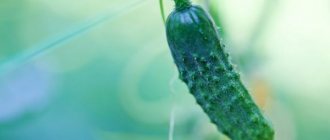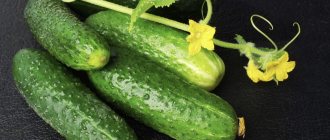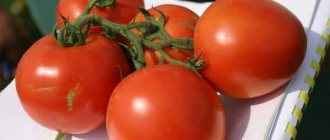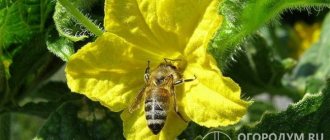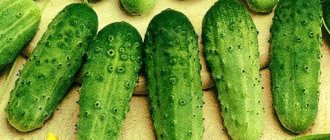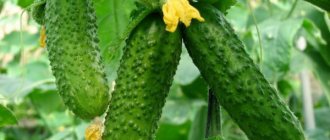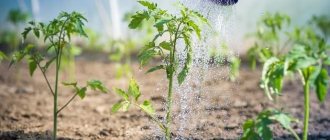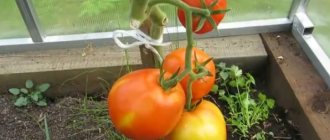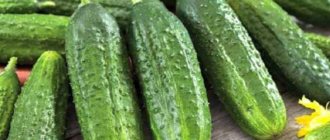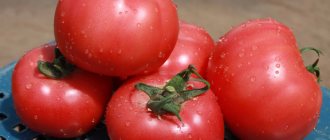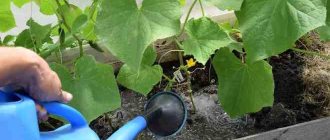Cucumber Capricorn F1 is a Turkish hybrid with excellent aroma and taste. It ripens quickly, and the fruits are suitable for both preparations and fresh salads.
| Landing location | Ripening time | Mode of application | Fruit length | Group | Fruit smoothness | Pollination method |
| Universal | Early ripening (35-45 days) | Universal | Medium - from 10 to 15 cm | Hybrid | Highly lumpy | Parthenocarpic |
Description of the variety
"Capricorn" refers to hybrids with early ripening. The first green plants are picked 32-35 days after the appearance of full shoots.
Fruit:
- They have a leveled, cylindrical shape and a short neck;
- Dark green in color, no white stripes;
- With a thin, medium-tubercular skin, with frequent pubescence and white spines;
- With dense, aromatic pulp;
- Gherkin type;
- Length - from 12 to 14 cm;
- Diameter - 3-3.5 cm;
- The average weight varies from 100 to 120 grams.
Bushes:
- Powerful, moderately tall, sparsely leafy;
- With shortened internodes and short side shoots;
- Leaves are medium and small in size;
- In each leaf node, 2 to 3 ovaries are formed;
- Bouquet type of flowering;
- With female flowers.
Characteristics of the variety
Cucumbers of the Capricorn F1 variety belong to the gherkin type, which is most in demand among summer residents today. Like all representatives of this family, the fruits grow neat and small in size: it is rare that the length of cucumbers exceeds 9 cm. But the greens must be collected quickly and on time, otherwise they will outgrow and lose their beautiful shape.
The variety is a hybrid and was bred in Turkey by agro collectors. It belongs to the parthenocarpic type, that is, it does not need bees to pollinate flowers.
“Capricorn” is an early variety that can be planted both in a greenhouse and in open ground, although growing in greenhouse conditions is preferable.
In closed ground conditions, this variety grows well and bears fruit both in spring-summer and winter-spring rotation.
The plant is characterized by sparse foliage, with short side shoots. The fruits grow in clusters, so the harvest will need to be harvested almost every day. One bush produces approximately 3 kg of fruits, distinguished by neat shape and size (see photo).
Cucumbers have excellent taste characteristics, in comparison with many greenhouse varieties, which have a somewhat muted and faintly pronounced cucumber taste. “Capricorn F1” can be consumed raw, pickled, or pickled. The variety is not afraid of transportation and is perfectly stored at home at room temperature.
Advantages and disadvantages
Hybrid "Capricorn" can be characterized by the following positive qualities:
- Ability to self-pollinate;
- Early ripening;
- Good keeping quality and transportability;
- Excellent taste characteristics;
- Resistance to elevated temperatures;
- Immunity to typical cucumber diseases;
- Excellent tolerance to lack of moisture;
- Lack of predisposition to overgrowth;
- Good germination of seed material (from 85 to 95%).
Gardeners did not identify any significant disadvantages to the hybrid.
Agricultural technology or proper cultivation
Growing through seedlings:
- You can sow seeds for seedlings in April;
- Seed material is buried 1.5-2 cm in separate cups;
- Required temperature for germination is +25 degrees;
- As soon as the frosts pass, cucumber seedlings are planted in the ground.
Sowing seed directly into the ground:
- Sowing seeds in open beds is carried out in soil heated to +14...+15 degrees. Approximate dates: second half of May - first ten days of June;
- Sow seeds to a depth of 2-3 cm;
- Recommended planting pattern - 70-90x30 cm;
- When the shoots reach a height of 3-5 cm, the plantings are thinned out, leaving 3-4 of the strongest seedlings in each hole.
The seed material is pre-treated by the manufacturer and therefore does not require disinfection, soaking or germination.
Rules for planting and care
The technology for growing these cucumbers is simple. When planting “Capricorn F1” on the site, follow a few simple rules:
- Like all cucumbers, this variety does not like cold weather. Low temperatures can negatively affect fruits and destroy plants. Ideal temperature is +15 degrees.
- Plants love soil with an acidity of 6-7 pH. It has been proven that this type of soil retains moisture well.
- You can water Capricorn F1 cucumbers once or twice a week.
- Despite the fact that cucumbers are very light-loving plants, it is not recommended to leave seedlings in the open sun in the heat. In the heat, the bushes can simply burn.
- Immediately after planting cucumber seedlings, the soil needs to be fed with organic fertilizers. Use compost or manure for these purposes.
- Do not thicken the plantings - the bushes grow powerful, and an excess of “neighbors” can provoke various diseases.
You need to be extremely careful with fertilizers containing nitrogen. Excess nitrogen can provoke active growth of the cucumber bush itself and significantly reduce its yield.
Care
Cucumber culture must be grown in soil with a pH of 6-7, this is the kind of soil that retains moisture well. Cucumbers are a light-loving crop, but you should avoid areas with constantly scorching sun.
Further care for the Capricorn hybrid:
- The frequency of watering is once or twice a week. The best option would be to install a drip irrigation system. It is advisable to apply overhead spraying in the first half of the day, this will allow the foliage to dry out in the evening. The soil is constantly kept moist;
- Immediately after planting cucumber seedlings, organic fertilizers are added to the soil. Compost or manure is used as organic matter. You need to be especially careful with nitrogen-containing fertilizers;
Excessive application of nitrogen promotes the active growth of the bush itself, and not the fruit, which will negatively affect the yield.
- The formation of a hybrid is carried out in one stem. The first three leaf axils are blinded, removing all the stepsons and ovaries. In the next 7-8 axils (at a distance of up to 100 cm from the surface of the earth), the ovaries are left, only the stepsons (side shoots of the first order) are removed. Further, up the central stem, stepchildren are also left, pinching them after 2-3 leaves (all ovaries are left on them, and shoots of the second order are removed). As soon as the main vine reaches the horizontal trellis wire, the stem is carefully wrapped around it several times and lowered down. Upon reaching 100-150 cm, the top is pinched;
- Warm weather conditions contribute to the rapid growth of cucumber crops. The green harvest is carried out every day. The optimal time for harvesting is early morning hours.
General description of cucumbers of the Capricorn F1 variety
Brief description of the variety:
- The type of variety is early ripening.
- Country of origin – Türkiye, Agro.
- The diameter and weight of the fruit is 3 cm, 100-150 g.
- Fruit length – 10 cm.
- The structure of the pulp is hard.
The Capricorn F1 variety is distinguished by high resistance to many diseases, including the cucumber mosaic virus and root rot. However, plants are not so resistant to true and downy mildew. With proper care, the first harvest can be expected within 40 days after germination.
Reviews about the variety from those who planted
Review from a gardener:
Of all the many positive characteristics of the Capricorn hybrid, gardeners highlight excellent immunity and resistance to moisture deficiency. The variety was especially appreciated by novice vegetable growers due to its ease of care.
The distinctive features of the Capricorn hybrid include good productivity, high regeneration, and versatility of cultivation (both indoors and outdoors). Even if the agrotechnical rules for growing the Capricorn hybrid were violated, the yield remains consistently high.
Review of the variety:
The perfect variety from sunny Turkey - Capricorn F1 cucumber: description and characteristics of the hybrid
Cucumber Capricorn F1 is a Turkish hybrid with excellent aroma and taste. It ripens quickly, and the fruits are suitable for both preparations and fresh salads.
| Landing location | Ripening time | Mode of application | Fruit length | Group | Fruit smoothness | Pollination method |
| Universal | Early ripening (35-45 days) | Universal | Medium - from 10 to 15 cm | Hybrid | Highly lumpy | Parthenocarpic |
The hybrid has tall, powerful bushes with short internodes. The fruits grow in small bunches - 2-3 pieces in each node. The flowers do not require pollination and set fruit themselves. Ripening occurs one and a half months after germination.
The fruits are medium-sized, 10-14 cm in length and 3-3.5 cm in diameter. Their weight is from 100 to 120 g. There are many small tubercles and white spines on the skin. The pulp is dense, juicy, crispy, with a pleasant taste and aroma. Universal use.
- excellent taste;
- early maturation;
- excellent presentation;
- resistance to heat;
- immunity to mosaic virus and root rot, average resistance to common and downy mildew.
Minuses:
From each bush you can get about 3 kg of greens.
Cucumbers are planted as seedlings in April, directly into the ground in May-June. Seedlings require small individual containers and a nutrient substrate. After germination, it is kept on a well-lit windowsill at a temperature of +18-21.
They are transferred to a permanent place after 25-30 days.
Water the bushes 1-2 times a week, but more often in hot weather. The water should be warm. On hot days, the bushes are artificially shaded.
Feed with mineral and organic fertilizers 2-3 times per season. Use weak solutions of manure, chicken droppings, superphosphate, and potassium nitrate.
Bushes are formed by removing all ovaries and lateral shoots from the axils of the three lower leaves. The remaining stepsons are pinched, allowing them to produce 2-3 leaves. At a height of 1-1.5 m, the main stem is also pinched and guided along a vertical support.
source
Gherkin cucumbers are the most popular among gardeners today. This plant crop differs from ordinary vegetables in appearance, taste, characteristics of cultivation, and care. There are a lot of varieties. The article will tell you how to choose suitable gherkin cucumbers, varieties of which are not difficult to care for and will produce a rich harvest of tasty fruits.
Many people believe that gherkins are a separate family of cucumber crops. But this is a misconception. The peculiarity of these fruits is their small size. Usually their size does not exceed 9 centimeters. To obtain gherkins, ordinary bush cucumbers are used, but they are harvested much earlier than ripeness - immediately after the start of flowering.
However, not all bush cucumbers for open ground are used for growing gherkins. Only narrow-fruited varieties are suitable.
General characteristics of gherkins are given below:
- The culture does not tolerate cold well. Already at +5 degrees, destructive damage appears.
- The acidity of the soil for such a plant should be in the range of 6.5-7 pH. This will ensure good moisture retention.
- Care must be special. After planting, organic matter is added to the ground. For example, compost or manure. You need to be extremely careful with nitrogen fertilizing. An excess of this substance provokes the growth of green vegetation and a decrease in yield. The bush should be watered at least 2 times every 14 days. These cucumbers love moisture. They also love the sun. However, in extreme heat it is necessary to shade the plant.
Despite the fact that gherkins are small in size, they have much more beneficial properties than larger fruits.
This is explained by the fact that part of the water in them is not 97%, but only 90%. The vegetable helps normalize the digestive tract, has a diuretic effect, and removes stones from the kidneys and gall bladder. The product is rich in macroelements such as sodium, magnesium, calcium and potassium. Regular consumption of gherkins has a strengthening effect on the nervous, endocrine and cardiovascular systems. Cucumber also contains vitamin C, which is so important for the formation of strong immunity. We advise you to look at the article about various diseases of cucumber seedlings.
Gherkins are available in different varieties. For example, Hummingbird, City Cucumber f1, Bouquet f1, Maryina Roshcha f1, Metelitsa f1, Salinas f1, Uranus, Pasamonte f1, Grandma's granddaughter and many others. It is impossible to consider all of them within one article.
Each gardener chooses the most suitable type for himself, but there are varieties that are most popular.
By choosing several options from them and planting them in the garden, you can easily decide which variety you like best.
Below are the most popular gherkins:
- Bush.
- Parisian gherkin.
- F1 is the envy of everyone.
- F1 perfection.
- Lilliputian F1.
- RMT F1.
- Caesar F1.
- Grandson of F1.
- Capricorn F1.
Let's consider the description of the Kustovaya cucumber as one of the varieties popular among summer residents.
This is a bee-pollinated variety. Designed for cultivation on open ground. The bush grows no higher than 70 centimeters. Gives small fruits. Their length varies from 9 to 12 centimeters. Weight reaches 90-110 grams. The shape is elongated ovoid. The surface is lumpy. The taste is excellent, there is no bitterness. The variety belongs to the early ripening varieties. The first harvest is harvested 46 days after germination. The Bush cucumber has a number of advantages: the harvested crop does not turn yellow and tolerates transportation well. The vegetable is universal. It is consumed fresh. They make salads from it. Used for pickling and salting.
The Parisian gherkin cucumber is a bush variety with early fruit ripening. From germination to harvest, only about 40 days pass. Bee-pollinated variety. Suitable for growing in greenhouses and open areas. The culture is medium-sized. Needs pinching.
Considering the description of the Parisian gherkin cucumber, one cannot help but note the high yield. Summer residents get up to 4 kilograms of vegetables per square meter. The taste of the fruit is excellent. The pulp is dense, crispy and juicy, without bitterness. The cucumber grows from 5 to 7 centimeters long. Its mass is 50-85 grams. The shape is spindle-shaped.
It should be noted that growing the Parisian gherkin cucumber is not accompanied by any serious problems. The variety is resistant to drought and has immunity to mosaic virus, cladosporiosis, and powdery mildew.
Almost all reviews about the Parisian gherkin cucumber are positive. Farmers note the excellent taste of the fruits, their presentable appearance, the ability of the crop to be stored for a long time and tolerate transportation well. The Parisian gherkin is the number one choice not only among experienced, but also among beginning gardeners.
Numerous positive reviews about the Envy of Everyone F1 unique cucumber indicate the high popularity of this variety. This is a gherkin hybrid. It is grown in spring greenhouses and on unprotected soil.
The main advantages are early ripening and high yield. Also, considering reviews of cucumbers Everyone is the envy of F1, it is worth saying that the culture is resistant to a number of diseases. Feels great in unfavorable environmental conditions. In any weather and climatic conditions, the plant bears fruit stably and abundantly. Moreover, active fruiting continues until the first frost.
A ripe cucumber, the envy of everyone, F1 has a length of 9-12 centimeters. Its color is bright green. The flesh is dense and crispy. The taste is excellent. The vegetable is well suited for pickling.
Some successfully grow to the envy of everyone indoors. And all thanks to the fact that the shrub does not need strong lighting and actively bears fruit even with a lack of sunlight. The variety is quite reliable, resistant to diseases and bad weather. And the reviews about cucumbers are proof of this to everyone’s envy.
Hybrid cucumbers Sheer perfection is distinguished by early ripening. They are grown in glass and film greenhouses, as well as on unprotected land. The variety does not require pollination.
The shrub produces medium-tubercular, cylindrical fruits. Each cucumber grows up to 8-9 centimeters in length. The color of the fruit is light green, there are longitudinal white stripes. The pulp is dense, aromatic and crispy. There is no bitterness. Cucumbers Sheer perfection have a universal purpose. They are consumed fresh and used for canning.
Mostly reviews of cucumbers Sheer perfection F1 are positive. Many summer residents note high yields. With good care, at least 28-30 kilograms of fruit are usually collected per square meter. The hybrid is easy to grow. He is not afraid of elevated temperatures and tolerates stressful conditions well. However, it requires abundant irrigation. Farmers say the only drawback is the high cost of seeds. And since perfection itself belongs to hybrid forms, it is not possible to use seeds from ripe fruits to grow a new crop. You have to purchase seed material from a specialized store.
Liliput F1 cucumbers are loved for the excellent taste of the fruit, their versatility, and the ease of growing the plant. The shrub is early ripening. The harvest is harvested 2 months from the date of planting. The culture is low. The vegetable has a cylindrical shape. Its length reaches 9 centimeters. And the average weight is 90 grams. The productivity is quite high. With proper care and favorable weather, about 11 kilograms of vegetables are harvested per square meter.
The main advantages of the Liliput hybrid include the following: the ability to self-pollinate, early ripening of fruits, the presentation of cucumbers, their ability to be stored for a long time, the bush’s resistance to a number of diseases, and ease of cultivation.
The variety does not require pollination. It is early ripening. The fruits ripen 40 days after germination. The bush is medium-sized. Each one produces 20 to 30 cucumbers. The vegetable has a cylindrical shape, its surface is a rich green color with whitish short stripes, and is covered entirely with tubercles. The mass of greens varies from 80 to 100 grams, and the length reaches 11 centimeters.
The pulp is crispy and has no bitter aftertaste. The hybrid is universal. The fruits are consumed fresh, as well as processed. An excellent vegetable for canning. Among the advantages of RMT F1, it is worth noting high yield, resistance to drought and heat. Fruiting lasts until autumn frosts. Cucumbers ripen together. The harvested crop is stored for a week without losing its presentable appearance or taste.
The hybrid form Caesar is loved by many beginners and experienced farmers. To understand why, it is worth considering the description of the Caesar F1 cucumber in more detail. This variety is grown both under cover and in unprotected garden plots. The plant is pollinated by bees. The shrub is vigorous and well developed. Is immune to tobacco mosaic virus, brown spot and powdery mildew.
Fruit ripening period is average. Typically, 50 to 55 days pass from germination to harvest. Cucumbers grow up to 8-12 centimeters long. The weight of each specimen reaches 200 grams. The vegetable has a rich green color. There are light streaks and small tubercles on the surface. The flesh is dense and crispy. Caesar is an ideal option for pickling. It is also consumed fresh. Also among the advantages, summer residents note the friendly ripening, presentation of cucumbers, and reasonable price for seeds. The only disadvantage is the short fruiting period.
Summer residents highly value the Vnuchok variety. Numerous reviews about the Grandson F1 cucumber indicate the presence of the following advantages: increased yield, resistance to common ailments, early ripening, long-term fruiting, excellent taste, keeping quality and presentability of the fruit.
The bush is indeterminate, branching is weak. Cucumbers ripen on the 45th day from the moment the seedlings are planted. Farmers harvest from 12 to 13 kilograms of crop per square meter. Each specimen weighs about 85-100 grams. The shape of the vegetable is cylindrical. The pulp is devoid of bitterness.
Good reviews of the Capricorn F1 cucumber also indicate that such a hybrid is considered a good choice for beginning gardeners. Productivity is high. One bush produces up to 3 kilograms of fruit. The taste of the vegetable is excellent. The value of Capricorn is that it is highly resistant to major diseases and tolerates moisture deficiency well.
There are different varieties that allow you to grow small, but tasty and healthy gherkin cucumbers. The varieties differ in color, fruit shape, weight and ripening time. What exactly to choose depends on the preferences of the summer resident. Check out the article: How to grow Herman F1 cucumber and what are its advantages?
source
Only original high-quality products, certificates for the entire range, planting material from the best nurseries in Ukraine and Europe.
You can choose any payment method convenient for you - online or cash on delivery upon receipt of the goods.
We constantly monitor prices and make sure that our customers make only profitable purchases.
| Planting depth | 3-4 cm |
| Fruit | Cylindrical |
| The soil | Moist, loose soil |
| Landing | Soil from 14 degrees |
| Ripening period | Early ripening |
| Package | 10 pieces |
| Productivity | 7-10 kg/m |
| Peculiarities | Suitable for spring and autumn growing |
| Mass/Weight | 120-140 gr |
| Length | 12-14 cm |
| Pollination | Self-pollinating |
| Grade | Hybrid |
| Culture | Vegetables |
We invite you to experience the benefits of shopping with the Svit Roslin online store. We are sure that we will meet again and again!
source
